warning Oldsmobile Achieva 1997 s Owner's Guide
[x] Cancel search | Manufacturer: OLDSMOBILE, Model Year: 1997, Model line: Achieva, Model: Oldsmobile Achieva 1997Pages: 372, PDF Size: 18.52 MB
Page 169 of 372
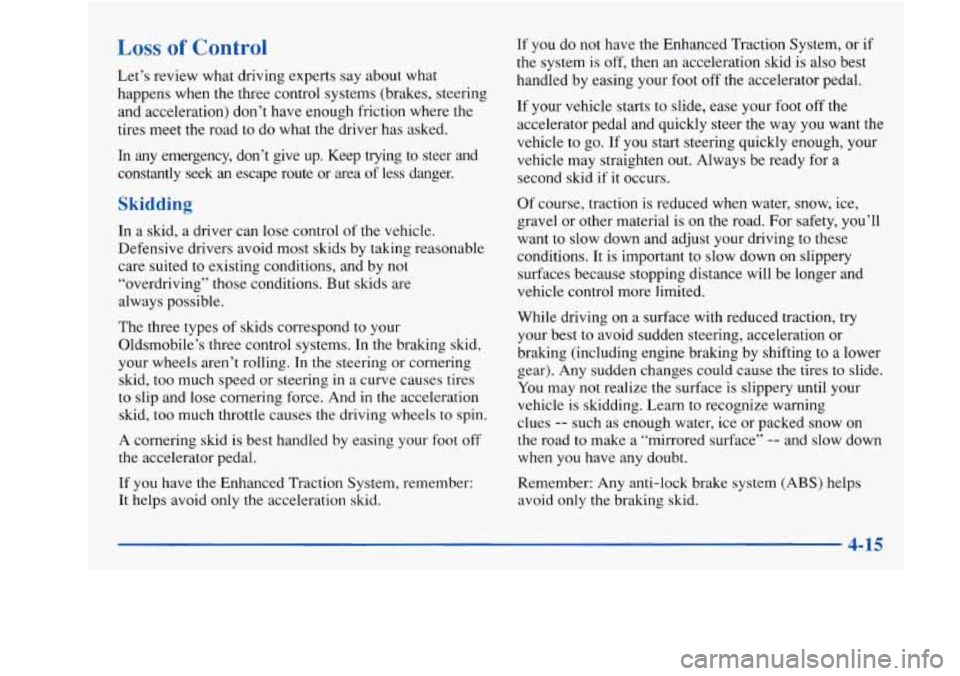
Loss of Control
Let’s review what driving experts say about what
happens when the three control systems (brakes, steering
and acceleration) don’t have enough friction where the
tires meet the road
to do what the driver has asked.
In any emergency, don’t give up. Keep trying to steer and
constantly seek
an escape route or area of less danger.
Skidding
In a skid, a driver can lose control of the vehicle.
Defensive drivers avoid most skids by taking reasonable
care suited to existing conditions, and by not
“overdriving” those conditions. But skids are
always possible.
The three types of skids correspond to your
Oldsmobile’s three control systems. In
the braking skid,
your wheels aren’t rolling. In the steering or cornering
skid, too much speed or steering in
a curve causes tires
to slip and lose cornering force. And in the acceleration
skid,
too much throttle causes the driving wheels to spin.
A cornering skid is best handled by easing your foot off
the accelerator pedal.
If you have the Enhanced Traction System, remember:
It helps avoid only
the acceleration skid.
If you do not have the Enhanced Traction System, or if
the system is off, then an acceleration skid is also best
handled by easing your foot
off the accelerator pedal.
If your vehicle starts to slide, ease your foot off the
accelerator pedal and quickly steer the way you want the
vehicle
to go. If you start steering quickly enough, your
vehicle may straighten out. Always be ready for a
second skid if
it occurs.
Of course, traction is reduced when water, snow, ice,
gravel or other material is on the road. For safety, you’ll
want to slow down and adjust your driving to these
conditions.
It is important to slow down on slippery
surfaces because stopping distance will be longer and
vehicle control more limited.
While driving on a surface with reduced traction, try
your best to avoid sudden steering, acceleration or
braking (including engine braking by shifting to a lower
gear). Any sudden changes could cause
the tires to slide.
You may
not realize the surface is slippery until your
vehicle is skidding. Learn to recognize warning
clues
-- such as enough water, ice or packed snow on
the road to make a “mirrored surface”
-- and slow down
when you have any doubt.
Remember: Any anti-lock brake system
(ABS) helps
avoid only the braking skid.
4-15
Page 175 of 372
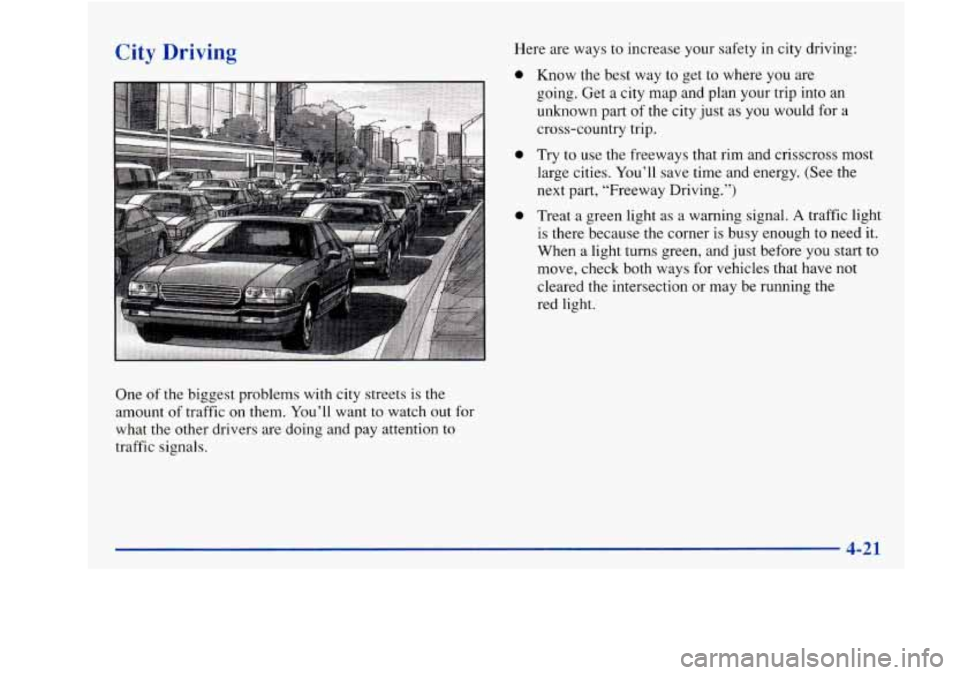
City Driving
One of the biggest problems with city streets is the
amount of traffic on them. You’ll want to watch out for
what the other drivers are doing and pay attention to
traffic signals. Here are ways
to increase your safety in city driving:
0 Know the best way to get to where you are
going. Get
a city map and plan your trip into an
unknown part of
the city just as you would for a
cross-country trip.
0 Try to use the freeways that rim and crisscross most
large cities. You’ll save time and energy. (See the
next part, “Freeway Driving.”)
0 Treat a green light as a warning signal. A traffic light
is there because the corner is busy enough to need it.
When a light turns green, and just before you start to
move, check both ways for vehicles that have not
cleared the intersection
or may be running the
red light.
Page 180 of 372
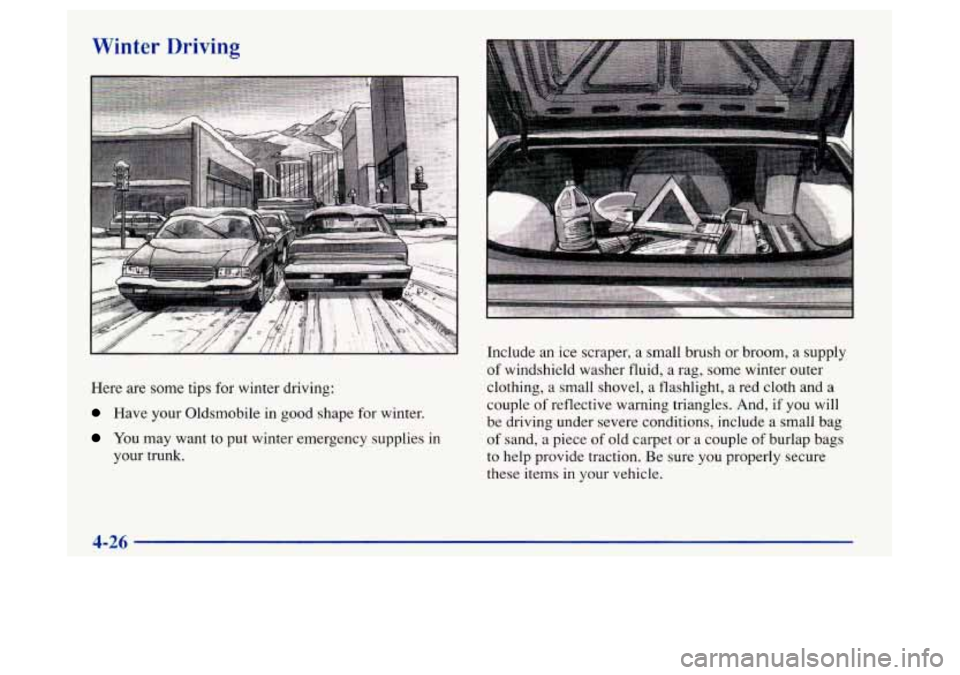
Winter Driving
Here are some tips for winter driving:
Have your Oldsmobile in good shape for winter.
You may want to put winter emergency supplies in
your trunk. Include
an ice scraper, a small brush or broom, a supply
of windshield washer fluid, a rag, some winter outer
clothing, a small shovel, a flashlight, a red cloth and
a
couple of reflective warning triangles. And, if you will
be driving under severe conditions, include a small bag
of sand, a piece of old carpet or a couple of burlap bags
to help provide traction. Be sure you properly secure
these items in your vehicle.
4-26
Page 197 of 372
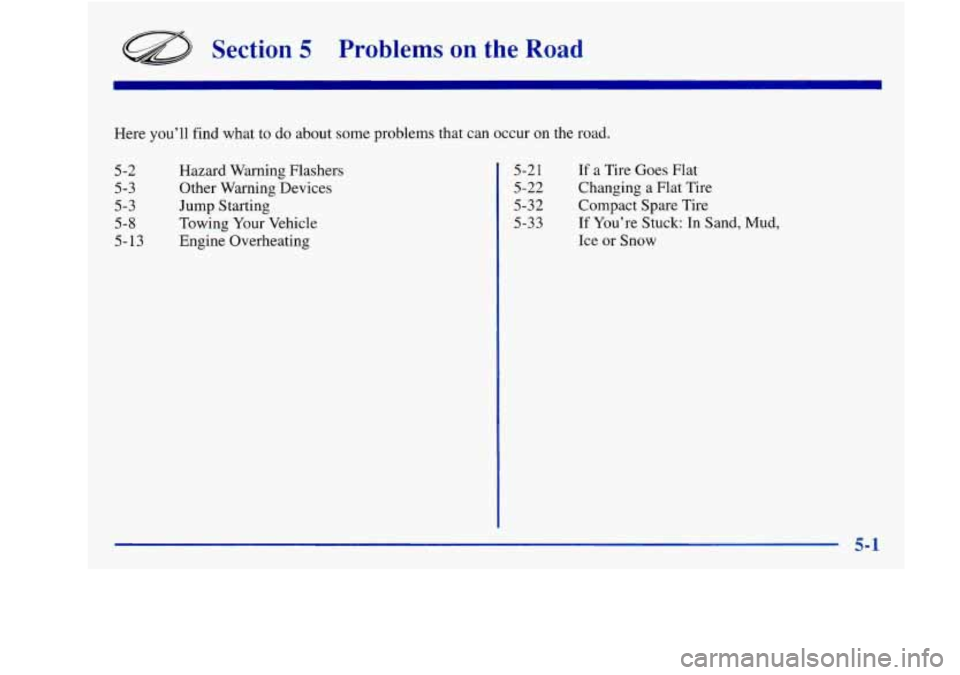
Section 5 Problems on the Road
Here you’ll find what to do about some problems that can occur on the road.
5-2 5-3
5-3 5-8
5-13 Hazard Warning Flashers
Other
Warning Devices
Jump Starting Towing Your Vehicle
Engine Overheating 5-21
5-22
5-32
5-33
If a Tire Goes Flat
Changing a Flat Tire
Compact
Spare Tire
If You’re Stuck: In Sand, Mud,
Ice or Snow
5-1
Page 198 of 372
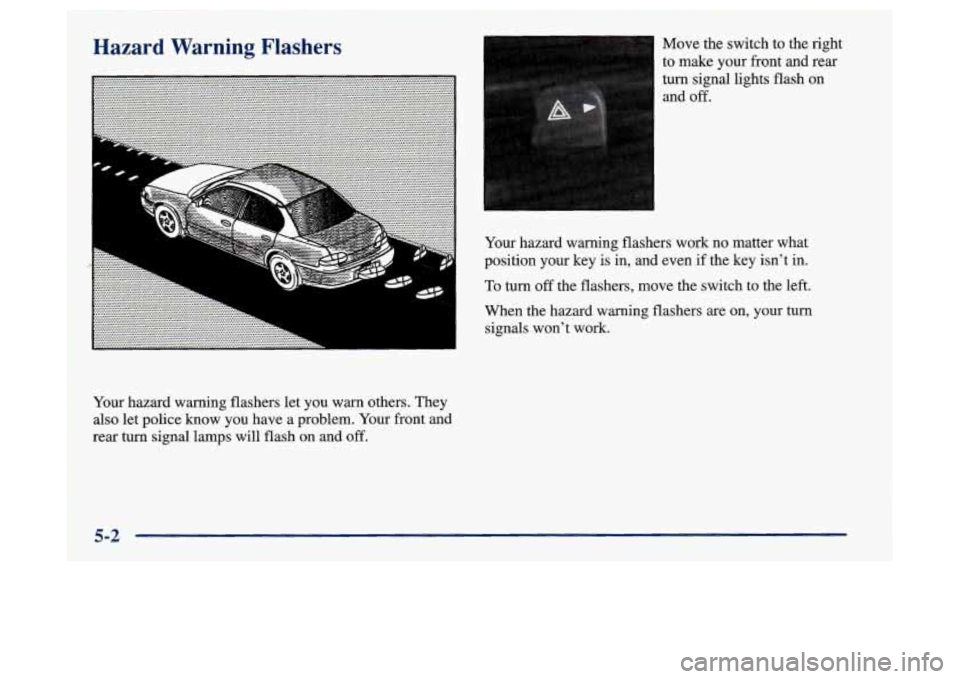
Hazard Warning Flashers
Your hazard warning flashers let you warn others. They
also let police know you have a problem. Your front and
rear turn signal lamps will flash on and
off.
Move the switch to the right
to make your front and rear
turn signal lights flash on
and off.
Your hazard warning flashers work no matter what
position your key
is in, and even if the key isn't in.
To turn off the flashers, move the switch to the left.
When the hazard warning flashers
are on, your turn
signals won't work.
5-2
Page 199 of 372

Other Warning Devices
If you carry reflective triangles, you can set one up at
the side
of the road about 300 feet (100 m) behind
your vehicle.
Jump Starting
If your battery has run down, you may want to use
another vehicle and some jumper cables
to start your
Oldsmobile.
But please follow the steps here to do
it safely.
I NOTICE:
Ignoring these steps could result in costly damage
to your vehicle that wouldn’t be covered by
your warranty.
Trying to
start your Oldsmobile by pushing or
pulling it could damage your vehicle, even if you
have a manual transaxle. And
if you have an
automatic transaxle, it won’t start that way. Batteries can hurt
you. They can be
dangerous because:
0 They contain acid that can burn you.
0 They contain gas that can explode or ignite.
They contain enough electricity to burn you.
If you don’t follow these steps exactly, some or all
of these things can hurt you.
1. Check the other vehicle. It must have a 12-volt
battery with
a negative ground system.
I NOTICE:
I
If the other system isn’t a 12-volt system with a
negative ground, both vehicles can be damaged.
Page 204 of 372
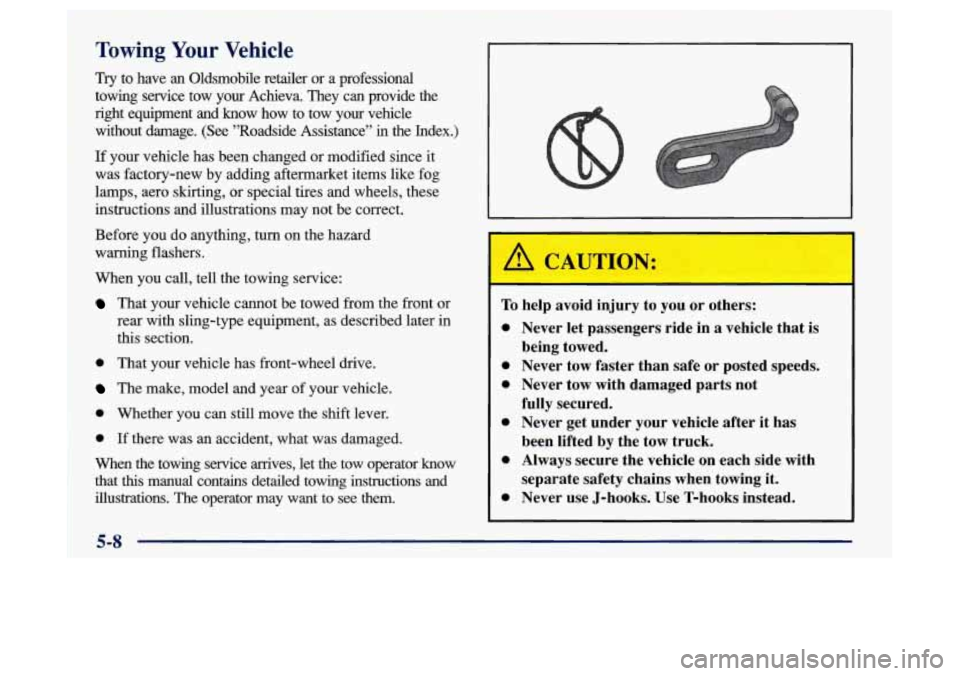
Towing Your Vehicle
Try to have an Oldsmobile retailer or a professional
towing service tow your Achieva. They can provide the
right equipment and know how to tow your vehicle without damage. (See ”Roadside Assistance” in the Index.)\
If your vehicle has been changed or modified since it
was factory-new by adding aftermarket items like fog
lamps, aero skirting, or special tires and wheels, these
instructions and illustrations may not be correct.
Before you do anything,
turn on the hazard
warning flashers.
When you call, tell the towing service:
That your vehicle cannot be towed from the front or
rear with sling-type equipment, as described later
in
this section.
0 That your vehicle has front-wheel drive.
The make, model and year of your vehicle.
0 Whether you can still move the shift lever.
0 If there was an accident, what was damaged.
When the towing service arrives, let
the tow operator know
that
this manual contains detailed towing instructions and
illustrations. The operator may want to see them.
I
t- To help avoid injury to you or others:
0
0
I. 0
0
0
Never let passengers ride in a vehicle that is
being towed.
Never tow faster than safe
or posted speeds.
Never tow with damaged parts not
fully secured.
Never get under your vehicle after it has
been lifted by the tow truck.
Always secure the vehicle on each side with
separate safety chains when towing
it.
Never use J-hooks. Use T-hooks instead.
5-8
Page 209 of 372
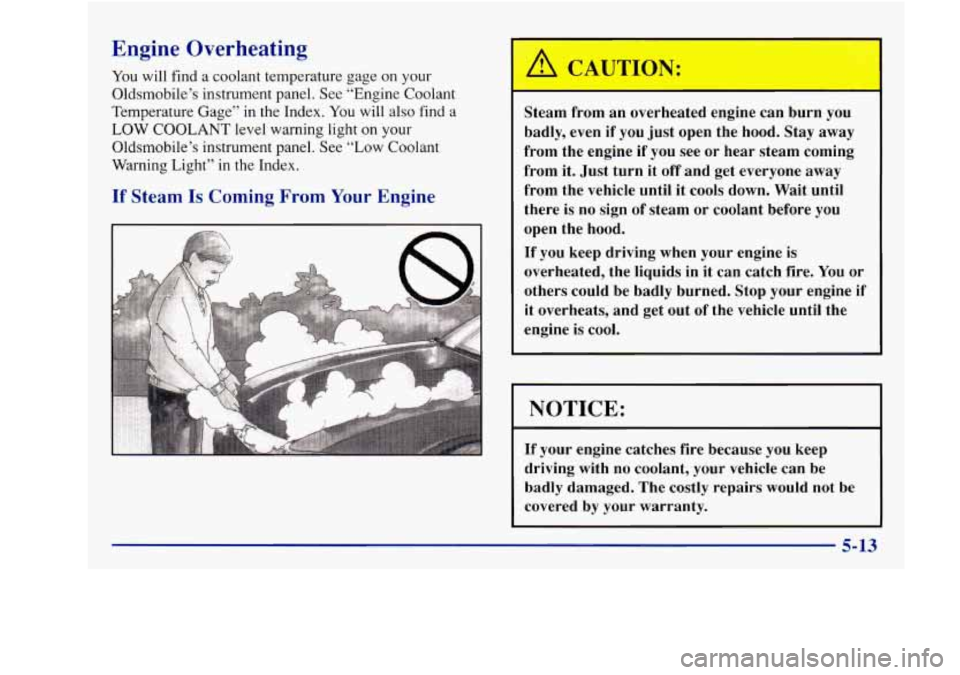
Engine Overheating
You will find a coolant temperature gage on your
Oldsmobile’s instrument panel. See “Engine Coolant
Temperature Gage” in the Index.
You will also find a
LOW COOLANT level warning light on your
Oldsmobile’s instrument panel. See “Low Coolant
Warning Light” in the Index.
If Steam Is Coming From Your Engine
/r CAUTION:
Steam from an overheated engine can burn you
badly, even
if you just open the hood. Stay away
from the engine if you see or hear steam coming
from it. Just turn it
off and get everyone away
from the vehicle until it cools down. Wait until
there is no sign of steam or coolant before
you
open the hood.
If you keep driving when your engine is
overheated, the liquids in it can catch fire. You or
others could be badly burned. Stop your engine if
it overheats, and get out of the vehicle until the
engine is cool.
I i
NOTICE:
If your engine catches fire because you keep
driving with no coolant, your vehicle can be
badly damaged. The costly repairs would not be
covered by your warranty.
Page 210 of 372
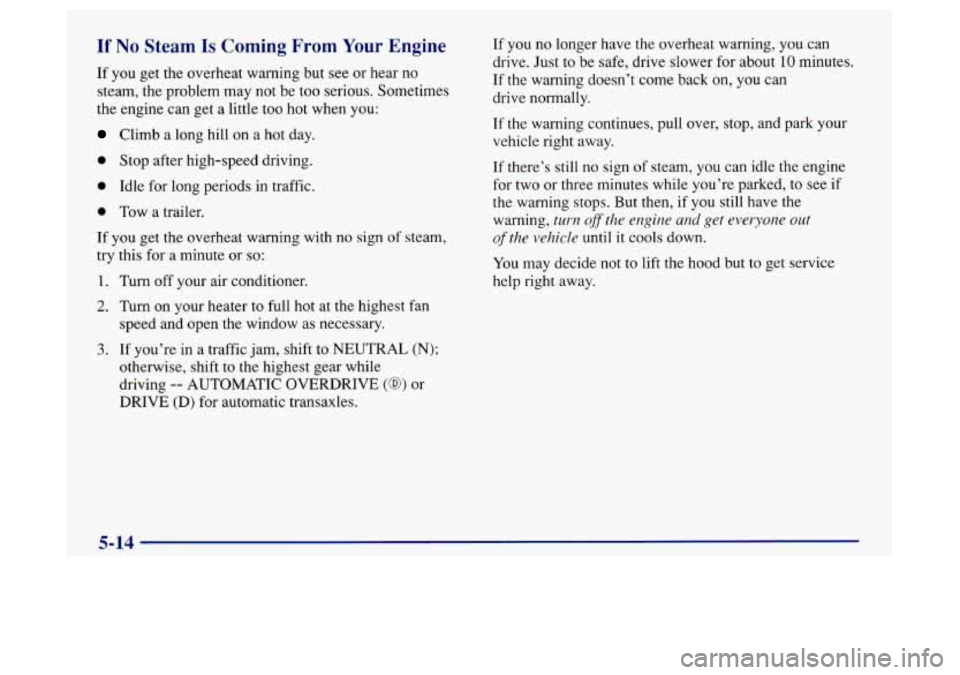
If No Steam Is Coming From Your Engine
If you get the overheat warning but see or hear no
steam, the problem may not be too serious. Sometimes
the engine can get a little too hot when you:
Climb a long hill on a hot day.
0 Stop after high-speed driving.
0 Idle for long periods in traffic.
0 Tow a trailer.
If you get the overheat warning with no sign of steam,
try this for a minute or
so:
1. Turn off your air conditioner.
2. Turn on your heater to full hot at the highest fan
speed and open the window as necessary.
3. If you’re in a traffic jam, shift to NEUTRAL (N);
otherwise, shift to the highest gear while
driving
-- AUTOMATIC OVERDRIVE (@) or
DRIVE
(D) for automatic transaxles. If
you no longer have the overheat warning, you can
drive. Just
to be safe, drive slower for about 10 minutes.
If
the warning doesn’t come back on, you can
drive normally.
If
the warning continues, pull over, stop, and park your
vehicle right away.
If there’s still
no sign of steam, you can idle the engine
for two or three minutes while you’re parked, to see if
the warning stops. But then,
if you still have the
warning,
turn ofthe engine and get everyone out
of the vehicle until it cools down.
You may decide not to lift the hood but to get service
help right away.
Page 214 of 372
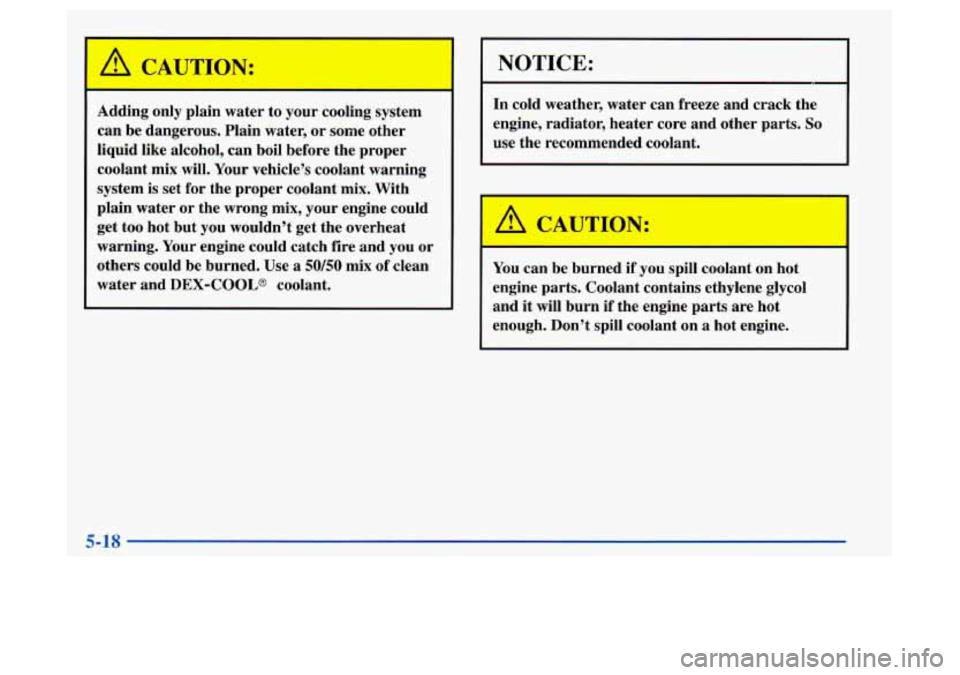
A CAUTION:
Adding only plain water to your cooling system
can be dangerous. Plain water, or some other
liquid like alcohol, can boil before the proper
coolant mix will. Your vehicle’s coolant warning
system is set for the proper coolant mix. With
plain water
or the wrong mix, your engine could
get too hot but you wouldn’t get the overheat
warning. Your engine could catch fire and you or
others could be burned. Use a
50/50 mix of clean
water and
DEX-COOL@ coolant.
I NOTICE:
In cold weather, water can freeze and crack the
engine, radiator, heater core and other parts.
So
use the recommended coolant.
A CAUTION:
You can be burned if you spill coolant on hot
engine parts. Coolant contains ethylene glycol
and it will burn if the engine parts are hot
enough. Don’t spill coolant on
a hot engine.
5-18